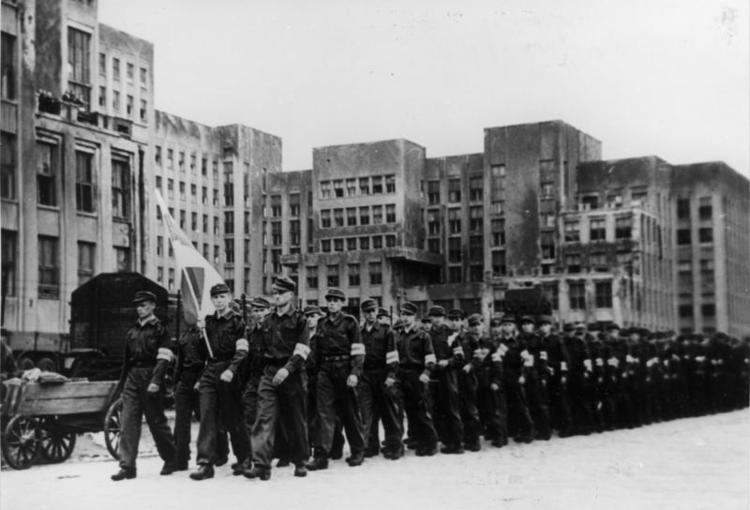Allegiance Nazi Germany Patron Radasłaŭ Astroŭski Founded 1944 | Size 28,000 troops Colours Feldgrau | |
 | ||
Active February 23, 1944 – April 28, 1945 Country Belarusian Central Rada Notable commanders Barys Rahula, Francišak Kušal, Ivan Yermachenka Similar Ukrainian Liberation Army, Russian Liberation Army, Russian Corps, Ukrainian National Army, Latvian Legion | ||
The Belarusian Home Defence, or the Byelorussian Home Guard (Belarusian: Беларуская краёвая абарона, Bielaruskaja Krajovaja Abarona, BKA) was a name of the collaborationist battalions of the Belarusian Central Rada (1943-1944), a pro-Nazi Belarusian council within Reichskommissariat Ostland during World War II.
Contents
The BKA operated from February 23, 1944 to April 28, 1945. The 20,000 strong Belarusian Home Defence Force was formed under the leadership of Commissioner-General Curt von Gottberg, with logistical help from the German 36th Waffen Grenadier Division of the SS known as the "Poachers' Brigade" commanded by Oskar Dirlewanger.
Creation of BKA
After the Wehrmacht suffered two major strategic defeats at Stalingrad (in February 1943) and at Kursk (in August 1943) the Germans made some concessions to the Belarusian collaborators by proposing a Belarusian quasi-state. Assistance was offered by the local administrative governments from the Soviet era, and former members of public organizations including the Soviet Belarusian Youth.
On March 6, 1944 the general mobilization of all healthy men born between 1908 and 1924 into the BKA started. Some 40,000 individuals reported to recruitment bureaus set up in seven cities; although 30% of them were sent back home on German orders for overcrowding. From each region (Uezd) about 500 to 600 men were recruited, for the total of 28,000 soldiers ready for training.
On March 26, all men already enlisted to the BKA gave their oath at Freedom Square in Minsk: "I swear, that arm to arm with the German soldier, I will not lay down my weapons until there is peace and security in our farms and cities, until in our land the last enemy of the Belarusian people is destroyed."
The oath was accepted by the BKA Belarusian commander Ivan Yermachenka, in the presence of the SS and Police Leader Curt von Gottberg. The president of the Belarusian Central Rada Radasłaŭ Astroŭski had concerns that some Soviet partisans might have infiltrated the new BKA structures and that therefore it would need a thorough inspection afterwards.
Auxiliary battalions
On March 31, 1944, the BKA battalions received their individual designations. In total, there were 45 battalions formed, mostly infantry. However, to prevent possible staged desertions to "forest people" weapons were handed out only during training exercises with nothing to spare. The German SS didn't have enough officers to train all of them, therefore a few thousand members of the Belarusian Auxiliary Police, not older than 57 years and Unteroffiziers not older than 55 years of age (except those protecting the collaborationist government), were brought into the fold of BKA. Organization was controlled by the German Police and SD commandants.
After training, the main assignments of BKA were the so-called anti-partisan operations in which some 30,000 Jews were killed (usually during "pacification" of villages). The anti-partisan struggle was a mask for the 'second wave of genocide' against the Jews (Raul Hilberg) led by Dirlewanger and von Gottberg after Operation Cottbus. [p. 24] Later, BKA was used at the front against the Red Army. Belarusian Central Rada sent the BKA throughout Belarus except the Pripyat River and around the town of Lida.
In mid-June 1944 an officer school for BKA volunteers was started in Minsk, but the city was overrun by the Soviets only two weeks later. After evacuating Rada to Königsberg and soon to Berlin in November 1944 along with upper echelon, the 1st personnel battalion was formed. Meanwhile, battalions of BKA on Belarusian territory, were mainly used in anti-partisan operations and later at the front against the Red Army, but the BKA ceased to exist after Soviets took over Belarus. Some BKA units retreated to the West. Many conscripts quietly went back home to their Belarusian villages.
The BCR formed under occupation of Belarus by Nazi Germany existed till late 1980s in the US and president Radasłaŭ Astroŭski worked till 1960. Most of its members, as members of other organizations, received political asylum as immigrants. In April and May 1945, most of the BKA and SBM submitted to Russian Liberation Army surrendered to the western Allies, knowing that in their motherland a long and difficult death by NKVD awaited them. Later propagandists hold that the Belarusian Liberation Armies 1st personnel battalion in Berlin in fact was a reserve for the 30th Waffen Grenadier Division of the SS (2nd Russian). Eleven its officers, including B. D. Rahula and others entered the 1st Grenadier Sturm Brigade SS "Belarus", formed in Nazi Germany; it was sent to the Battle of Monte Cassino, and acted against the II Corps (Poland) of General Władysław Anders (Anders Army). BKA soldiers were not trusted by the Germans, which explains why Russian Liberation Army formations weren't sent to the Eastern Front, and combat at Western Front.
